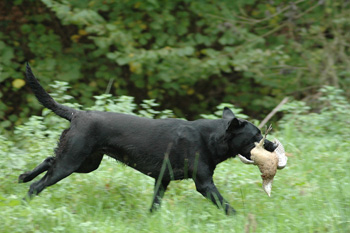Gundog disipline – how much is too much?

JEREMY HUNT SAYS: Training a gun dog is a partnership and in my book you both have to enjoy it and your gun dog certainly has to know when he has undertaken a task correctly.
In the early stages of training encouragement has to form the basis of transmitting to your gun dog what you want- and there’s nothing to beat it.
But as your gun dog progresses in his work the bond between the two of you should be such that he becomes confident in knowing that what he is doing is what you want him to do without being totally dependent on masses of encouragement.
In other words, your approach to training should steadily start to become more subtle while still achieving the desired result such as a swift and stylish retrieve or persistent game-finding.
The two elements of gun dog training are the gun dog and the handler.
The problem we have these days is a lack of patience on the part of handlers.
Gun dogs that are often too ‘hot’ for amateurs to work with and an assumption that by rigidly following a step-by-step guide to training through a DVD or a book – with much of the early training undertaken in the predictable confines of the garden – will deliver the goods.
Of course that isn’t the case.
Successful training is built on the close bond that is created between gun dog and handler – and it’s an understanding that cannot be gained from any training manual.
Your gun dog has to understand you and you have to understand your gun dog.
And by that I mean you have to know him inside out so that your training sessions are not simply a methodical set of exercises but an opportunity for you to learn together and work as a team.
In many cases, young gun dogs fail to achieve what’s wanted from them simply because they don’t understand what you have asked them to do in a clear and correct manner.
Understated handling, which demonstrates the unseen but vital link that you have with your gun dog and his understanding of the job in hand, should be your aim.
Once you have achieved that glorious state of rapport with your gun dog – and remember he will know your shortcomings just as you know his- it can often be a case of less is more.
Encouragement is essential in the early stages of training but an understated and more subtle approach to handling should be your ultimate target.
For more gun dog training advice click here








